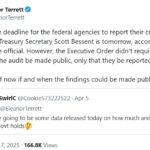In a recent post on Truth Social, former President Donald Trump has reignited discussions around the Federal Reserve’s interest rates, asserting there is currently no inflation and advocating for rate cuts. His remarks come amidst significant fluctuations in the markets, especially following his announcement of increased tariffs on several nations, which he claims are necessary to correct longstanding trade imbalances with China.
“Oil prices are down, interest rates are down…there is NO INFLATION,” Trump declared, emphasizing what he views as favorable economic indicators.
Trump’s claims of “no inflation” stand in stark contrast to the economic turbulence that has followed his recent tariff policies. As reported, the Nasdaq index has experienced its lowest point since January 2024, and Bitcoin saw a decline, dropping below $75,000 early Monday. These developments are symptomatic of a broader market uncertainty licking the wounds of geopolitical tensions, particularly with China.
The former President’s tariffs, increasing the total levy on imports from China to 54%, have triggered retaliatory measures from Beijing, contributing to the current market volatility. In light of these tensions, Trump’s sentiments on the need for Federal Reserve easing appear to align with market expectations of potential rate cuts this year, which could be aimed at cushioning the economy from the aftershocks of his aggressive trade policy.
“The biggest abuser of them all, China… just raised its Tariffs by 34%,” Trump asserted, placing blame on previous leadership for permitting China’s economic strategies.
In addition to the tense trade relations, the decision by OPEC to increase oil production has resulted in a notable decline in crude oil prices, falling by 16% to $60 per barrel in a matter of days. This price drop is noted for its disinflationary effects, which could influence both consumer prices and overall market conditions. Observers suggest that such dynamics might necessitate some monetary policy adjustments from the Federal Reserve as the economic landscape continues to shift.
Trump’s steadfast position on tariffs and the Fed’s role reflects a complex interplay between domestic policy and global economic forces, as he emphasizes the need for America to reassess its trade positions and strengthen its economy moving forward.

Impact of Trump’s Economic Strategies on Inflation and Markets
The recent statements from President Donald Trump regarding interest rates and tariffs offer critical insights into the economic landscape and its potential effects on everyday life.
- Fed Rate Cuts Advocacy
- Trump urges the Federal Reserve to cut interest rates, claiming there is no inflation.
- Such cuts could lower borrowing costs for consumers and businesses, potentially stimulating economic growth.
- Declining Oil Prices
- WTI crude oil prices have dropped significantly by 16% to $60 per barrel, which could lead to lower transportation and product costs.
- This decline may play a role in easing inflationary pressures globally, affecting everyday pricing for consumers.
- Tariffs and Market Impact
- Trump’s implementation of tariffs on China raised their levy to 54%, leading to potential retaliatory actions.
- Market reactions have been negative, with significant drops in the tech-heavy Nasdaq index and Bitcoin values.
- China’s Trade Position
- Trump accuses China of taking advantage of the U.S. through trade practices and high tariffs.
- Trade tensions may continue influencing global markets, likely affecting prices of goods and services.
- Overall Economic Climate
- The interplay between Fed policy, oil prices, and tariffs could create a volatile economic environment.
- Consumers may face unpredictability in prices, employment, and investment opportunities based on these policies.
“Our past ‘leaders’ are to blame for allowing this, and so much else, to happen to our Country. MAKE AMERICA GREAT AGAIN!”
Trump’s Economic Agenda: Rate Cuts, Tariffs, and Market Reactions
In a bold move, former President Donald Trump has once again voiced his perspective on the Federal Reserve’s monetary policy, claiming that current market conditions warrant significant interest rate cuts. His emphasis on the absence of inflation, despite rising tariffs and a fluctuating market, appears to position him as a champion for the average American consumer. However, this assertion comes amidst points of contention that could either benefit or hinder various stakeholders in the economy.
On one hand, Trump’s call for decreasing interest rates aligns with the expectations of many market analysts who predict multiple cuts this year. This approach could provide much-needed relief to businesses struggling in the face of his recently imposed tariffs, particularly those within the technology sector and small-to-medium enterprises that may be more sensitive to interest rate fluctuations. If the Fed responds favorably, it might bolster investor confidence, providing a cushion against the adverse effects of escalating trade tensions, especially with China. Lower rates could also stimulate borrowing, sparking investment and economic activity in the short term.
However, overlooking the retaliatory tariffs on China—now at a staggering 54%—could create significant challenges. Trump’s aggressive stance on trade has already led to market instability, with tech-heavy indexes plummeting, reflecting fears of a prolonged trade war. The resultant market volatility poses risks not just to U.S. equities but also adversely affects global economic perceptions, keeping investors on edge. It’s a double-edged sword: while some companies may benefit from decreased rates, others heavily reliant on Chinese imports could suffer from increased costs and disrupted supply chains.
Moreover, the recent drop in oil prices further complicates matters. The West Texas Intermediate crude has seen a startling decline, and while lower oil prices can indeed introduce disinflationary trends, creating a paradox in the inflation narrative, energy companies and oil-dependent economies are left reeling. These dynamics could exacerbate existing tensions within the energy sector, resulting in job losses and destabilizing local economies reliant on oil production.
The former president’s rhetoric positions him as a protector of American economic interests, yet it also risks alienating critical trading partners, particularly as retaliatory tariffs loom large. Industries focused on international trade or those engaging with China directly could face significant hurdles, leading to a reassessment of partnerships and market strategies. In summary, Trump’s dual push for Fed rate cuts amidst aggressive trade policies offers both potential advantages for some sectors, while simultaneously challenging existing economic relationships, thereby creating a nuanced landscape for businesses and consumers alike.

















